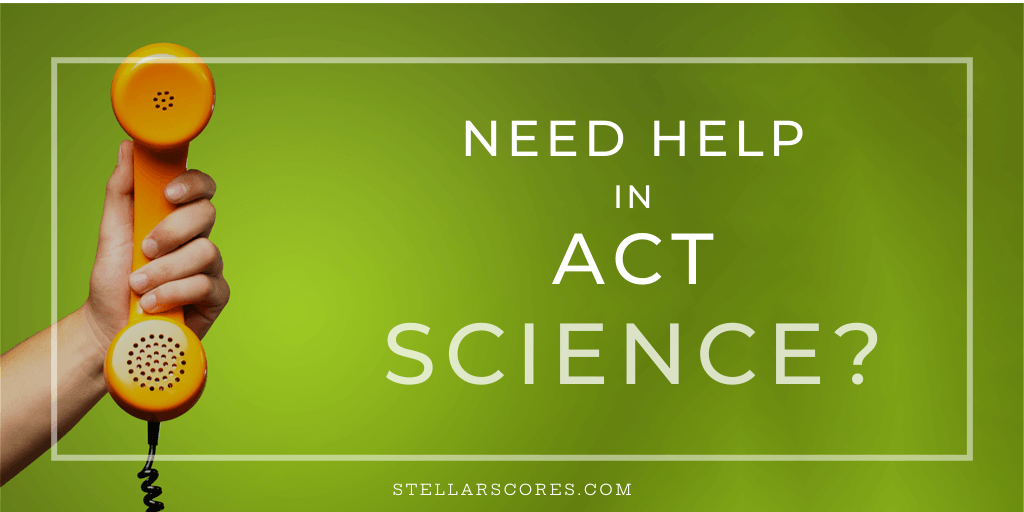
The ACT science is the most dreaded of all the SAT and ACT test sections. It single-handedly turns more kids away from the ACT than any other section. But it doesn’t have to be this way.
Here are my 6 favorite tips that my students use to consistently score well in ACT Science.
1. You don’t actually need to know science
I’m many (many) years out of science class in high school and I majored in English in college, so to say I’m not a science person is a bit of an understatement. I couldn’t tell you in which phyla snails belong or how to calculate Brownian motion. Luckily, we don’t need to know any of that for the ACT Science section.
2. You do need to know how to interpret charts and graphs
I know they call it a Science section, but it should really be named the Reading-and-Interpreting-Dry-and-Complex-Charts-and-Graphs section.
You do need to know how to read complex charts and graphs and make inferences from the data. I think of it as a reading section with charts and graphs. All the strengths you bring to the reading section – attention to detail, inferring data from the text, making reasoned assumptions – ALSO apply to the science section.
3. Don’t read the passages first (instead find Waldo)
In the reading section of the ACT (and the SAT) you ABSOLUTELY need to read the passage first. But not for the ACT Science passages (except for the conflicting viewpoints passage).
DON’T read the passage ahead of time. Just lightly skim it – “hmm.. it looks like this passage is about butterflies and the first chart looks at temperature compared to longevity and the second chart looks at caterpillar volume compared to food source.”
Here’s why: The ACT Science passages are dry, dense, and confusing material that you probably are not going to completely understand. And you don’t need to. You just need to understand enough to answer the questions correctly.
So you first go to the questions and then go back to the passage to find the data that you need to answer the questions. “Hmm.. question 1 asks about which is the best food source – I need to look at Figure 2 in order to find the answer.”
Go straight to the questions to understand what you are looking for and then go back to the passage and find the answers to what you need. (So you do actually end up reading the passages, but through the lens of the questions.)
4. Look for trends
Instead of trying to understand the numbers in isolation, look for trends. More questions will ask you about trends in the data than about an individual value.
5. Look for commonalities
Questions that ask you about two or more figures or graphs can be tough. They are usually about different aspects of the experiment – so it can be hard to track one variable from one graph to the other.
For example, one graph will tell you about the temperature compared to longevity of butterflies and the second graph will tell you about caterpillar volume compared to food source. One question will ask you about low temperatures vs food source. But there’s no graph for that!
The key is to find the common element that ties the data together. Reading the paragraph you discover that willows thrive in lower temperatures. So you would first find the longevity of butterflies in lower temperatures in the first graph, then look for willows as a food source in the second graph and find the caterpillar volume.
6. Be strategic
The questions are roughly arranged in order of difficulty in each passage (but not across the passages as a whole). Which means that question 1 is easier than question 6 in passage 1, and question 17 in passage 4 is easier than question 20 in passage 4, but passage 4 is no more difficulty than passage 1.
Remember that every question is worth one point. So don’t get too caught up on any one question. Just guess if you need to and move on (especially if you are stuck on the last few questions in a passage – there are probably easier questions at the beginning of the next passage)
My favorite ACT Science book
My absolute favorite book on the subject is For the Love of ACT Science.
Michael Cerro is a tutor and it shows – he breaks down question types, teaches you how to handle each one, and then gradually increases the complexity and variety of the questions, until you are practicing on something that feels a lot like a real ACT Science section. He also has a specific chapter on how to handle the conflicting viewpoints passage.
